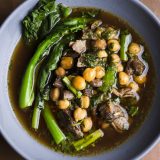On a chilly February day in China’s Yunnan province, cookbook author Naomi Duguid and her family got their first taste of niu rou fang zang, a warming stew of tender beef and chickpeas that also happens to be a delicious mystery.
The soul of this stew is its mix of spices: star anise, Sichuan peppercorns and dried red chilies. Together, they do the heavy lifting of flavor building. Sautéed in oil or beef drippings along with copious amounts of chopped aromatics, the spices help to create a bold base before the chickpeas and meat (which is typically either beef or lamb) are combined in the pot.
Perhaps the most unusual element of the dish, though, is the chickpeas, which are a rarely used ingredient in China. So where did they come from?
Duguid points out that Yunnan presents ample opportunities for cross-cultural pollination. It’s a region with a large population of Hui people (a predominantly Muslim ethnic group), and its borders include not only the Chinese provinces of Sichuan and Guizhou, but also Tibet, Myanmar, Laos and Vietnam. “Perhaps the chickpeas came into the Hui repertoire via trans-Himalayan influence, from northern India, but we don’t really know,” she says.
Its origins may be murky, but niu rou fang zang itself is exceptionally vibrant, a simple dish full of complex flavors that we sought to re-create at Milk Street.
The broth is so flavorful, in fact, that it allows us to forgo searing the meat before adding it to the stew. Without searing, the broth boasts a clean, pure beefiness, so the complexity of the spices truly shines. Here, we opt for beef shanks. We found that the bones add an amazing richness that rounds everything out with savory depth.
Chinese-Spiced Beef Stew
Pervaiz Shallwani
March-April 2022

Get the Recipe
Chinese Beef Stew with Chickpeas and Star Anise
Star anise, Sichuan pepper and five-spice powder build complexity in this stew.
Photo: Connie Miller of CB Creatives; Styling: Christine Tobin







